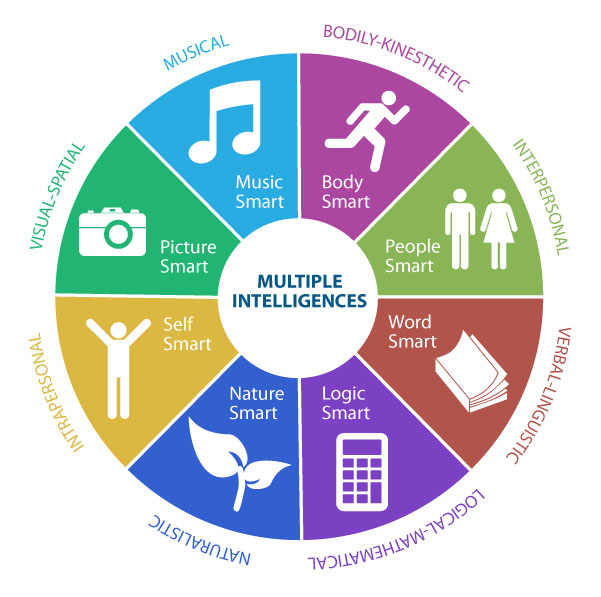
Howard Gardner’s theory of multiple intelligences first emerged in 1983. As a developmental psychologist, Gardner believed that we all have these intelligences, and that our profile may vary individually based on genetics or experience (Marenus, 2023).
Given our more recent understanding of neuroplasticity, it’s plausible that we can develop different types of intelligence based on our changing interests and experiences as we go through life. On a personal level, I know that my ‘weakest’ areas of intelligence are probably logical-mathematical (I can be logical and I would say I’m fairly good at problem-solving and rationalising, but I had a poor experience of maths, physics and chemistry at school and have very little enthusiasm for working with numbers or graphs) and spatial (I am not the most observant person as I tend to spend most of the time in my own head, and I can be creative but struggle to visualise my ideas spatially). Up to about 10 years ago, I would have also said intrapersonal intelligence was an area of weakness. However, I have spent considerable time and effort in recent years on understanding myself, what I feel and what I want out of life, something that was neglected in my childhood and early adulthood due to an exclusive focus on outcomes (good grades, good university, good job, earning good money, etc.) learned from my parents and schooling. This makes me inclined to believe Gardner’s theory that we do all have all these intelligences to a greater or lesser extent, but they may not have been an area of focus or we may not have had enough opportunity to develop them.
“Research shows that students are more engaged and learn best when they are given various ways to demonstrate their knowledge and skills, which also helps teachers more accurately assess student learning.”
Darling-hammond, 2010 as cited in marenus, 2023
From an educator’s perspective, the multiple intelligences theory is another planning framework that can help us build quality curricula and create lessons and activities that support more intelligences to provide inclusive, positive learning experiences for all our students. It also reminds us that academic excellence is just one type of intelligence and that there are many others and even more combinations of intelligence. Traditionally, education and assessment has prioritised linguistic and logical-mathematical intelligences. Education for the future should prioritise all intelligences so it is inclusive and creates young people who are able to contribute to society in diverse ways with equity.
Technology and pedagogy combined can help educators support multiple intelligences in the following way:
make use of different digital formats and applications in activities (google docs, padlet, kahoot, photos, videos, audio, music, virtual trips, surveys & quizzes, games, etc.)
enable project based learning both individually and in groups (collaboration sites like google suite, zoom/teams/skype to link with students or experts in other locations)
enable students to reflect on and record their learning (blogs, vlogs, digital music, eportfolios, videos, podcasts, etc.).
Adapted from Kurt (2020).
References
Kurt, S. (2020, December 19). Theory of multiple intelligences – Gardner. Educational Technology. https://educationaltechnology.net/theory-of-multiple-intelligences-gardner/
Marenus, M. (2023, May 18). Howard Gardner’s theory of multiple intelligences. SimplyPsychology. https://www.simplypsychology.org/multiple-intelligences.html
